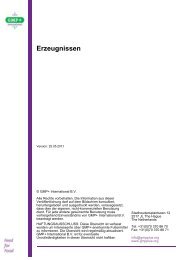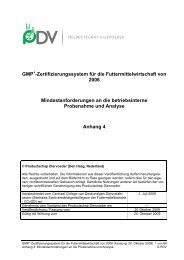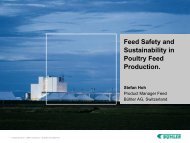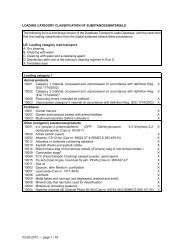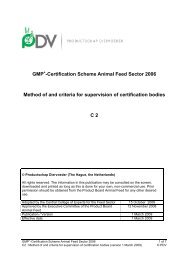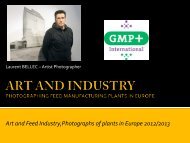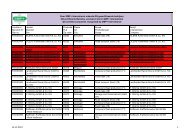Certification Scheme Animal Feed Sector 2006 ... - Gmpplus.org
Certification Scheme Animal Feed Sector 2006 ... - Gmpplus.org
Certification Scheme Animal Feed Sector 2006 ... - Gmpplus.org
You also want an ePaper? Increase the reach of your titles
YUMPU automatically turns print PDFs into web optimized ePapers that Google loves.
ANNEX A: INSTRUCTIONS FOR TRANSPORT SEQUENCE, CLEANING AND<br />
DISINFECTION<br />
Instructions for transport sequence, cleaning and disinfection<br />
Previous load Following load<br />
Loading Description State of the bulk <strong>Animal</strong> feed<br />
<strong>Animal</strong> feed products<br />
for laying poultry<br />
category of the loading category<br />
Very high-risk materials<br />
loading compartment products<br />
LR 1 (prohibited load) n/a Not allowed<br />
LR 1 (E) (Products containing)<br />
a<br />
processed animal proteins<br />
n/a<br />
Not allowed Requirements for the release of<br />
transport means for the transport of animal<br />
feed are set in (EC) 999/2001 and by the<br />
competent authority.<br />
Microbiologically<br />
After unloading A+D<br />
LR 2 contaminated materials (for<br />
example Salmonella) or<br />
perceivable signs of decay<br />
(for example abnormal<br />
odours)<br />
Residue after dry<br />
cleaning<br />
(Odour) residue after<br />
cleaning with water<br />
B+D<br />
C+D<br />
Residue after dry<br />
B+D<br />
LR 2 <strong>Feed</strong> materials of animal cleaning<br />
R&O in accordance with applicable legislation<br />
(Vdo) origin (which do not belong to<br />
loading category 1(E)) (Odeur)residue after<br />
cleaning with water<br />
(EC 1774/2002)<br />
C+D<br />
R&O in accordance with applicable legislation<br />
(EC 1774/2002)<br />
after unloading B<br />
LR 3 Material constituting a (Odour) residue after<br />
physical and/or chemical risk cleaning with water<br />
C<br />
after unloading A<br />
Residue after dry<br />
B<br />
LR 4 Neutral material<br />
cleaning<br />
(Odour) residue after<br />
cleaning with water<br />
C<br />
after unloading A<br />
LR 4 (E) (Products containing)<br />
processed animal proteins<br />
Residue after dry<br />
cleaning<br />
B<br />
a<br />
(Odour) residue after<br />
cleaning with water<br />
C<br />
after unloading A<br />
b<br />
A<br />
Residue after dry<br />
cleaning<br />
B B b<br />
LR 4 (T) Compound feeds with<br />
nicarbazine and medicated<br />
feeds with sulpha-agents<br />
Residue after<br />
cleaning with water<br />
C<br />
b<br />
C<br />
LR: Loading category road transport E: (Processed) animal proteins<br />
A. Dry cleaning Vdo: <strong>Feed</strong> materials of animal origin<br />
B. Cleaning with water T : Compound feeds with nicarbazine or sulphas<br />
C. Cleaning with water and a cleansing agent<br />
D. Disinfection after one of the previous cleaning regimes (A, B or C<br />
a By processed animal proteins, the following is meant here: all processed animal proteins as defined in the <strong>Animal</strong> Byproducts<br />
Regulation (EU 1774/2002). It also includes products that contain these proteins, and compound feeds and premixes not containing<br />
these proteins in the ingredients, but originating from production lines containing these proteins. Exceptions to this are milk and products<br />
based on milk, colostrum, eggs and egg products and collagen. Definition of processed animal proteins: animal proteins that were<br />
derived fully from category 3 material and that were processed in accordance with Appendix V, Chapter II (EU 1774/2002) in order to<br />
make these suitable as direct feedstuffs or to be used otherwise in animal feed, including pet food, or in biological fertilizers or soil<br />
improvers.<br />
b The specified cleaning instructions only apply when the manufacturer can show that the end feed remains under the total carry-over<br />
norms (factory carry-over including the carry-over during transport). For the carry-over of nircarbazine/sulpha’s during transport 0.03%<br />
may be assumed if use is made of a bulk tanker where the compartments are pressurised during unloading. If a company is unable to<br />
show that the end feed remains under the total carry-over norms then a very penetrating and strict cleaning procedure should be used.<br />
It must be demonstrated with very clear documentation in what manner the carry-over is controlled (for example by way of flush<br />
batches).<br />
GMP+ <strong>Certification</strong> <strong>Scheme</strong> <strong>Animal</strong> <strong>Feed</strong> <strong>Sector</strong> <strong>2006</strong> 7 of 26<br />
Appendix 14 : Minimum requirements for Road Transport (version 16 November 2007) © PDV



